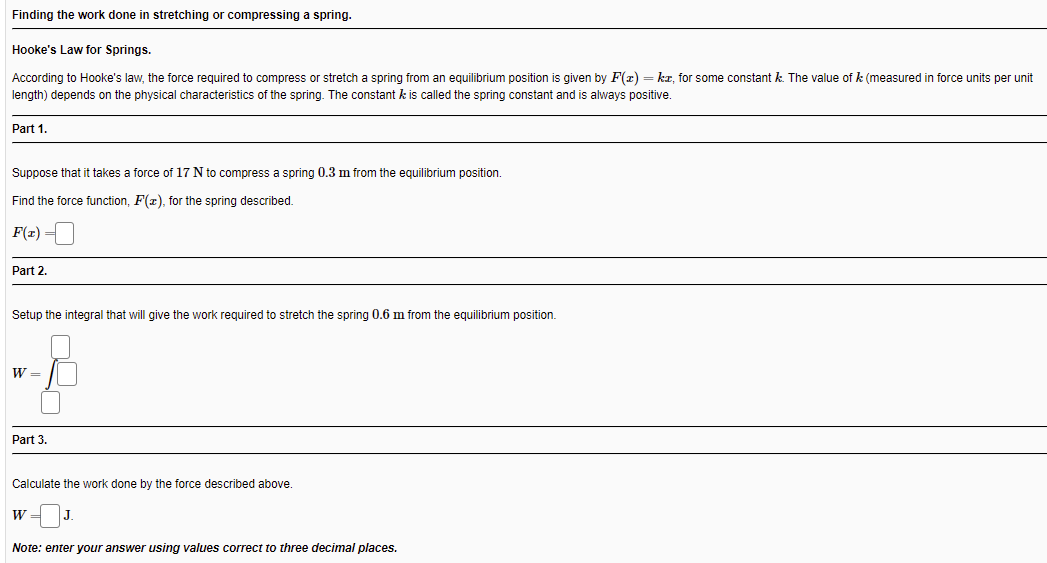Finding the work done in stretching or compressing a spring. Hooke's Law for Springs. According to Hooke's law, the force required to compress or stretch a spring from an equilibrium position is given by F(x) = kr, for some constant k. The value of k (measured in force units per ur length) depends on the physical characteristics of the spring. The constant k is called the spring constant and is always positive. Part 1. Suppose that it takes a force of 17 N to compress a spring 0.3 m from the equilibrium position. Find the force function, F(x), for the spring described. F(z) = Part 2. Setup the integral that will give the work required to stretch the spring 0.6 m from the equilibrium position. W =
Finding the work done in stretching or compressing a spring. Hooke's Law for Springs. According to Hooke's law, the force required to compress or stretch a spring from an equilibrium position is given by F(x) = kr, for some constant k. The value of k (measured in force units per ur length) depends on the physical characteristics of the spring. The constant k is called the spring constant and is always positive. Part 1. Suppose that it takes a force of 17 N to compress a spring 0.3 m from the equilibrium position. Find the force function, F(x), for the spring described. F(z) = Part 2. Setup the integral that will give the work required to stretch the spring 0.6 m from the equilibrium position. W =
College Algebra
7th Edition
ISBN:9781305115545
Author:James Stewart, Lothar Redlin, Saleem Watson
Publisher:James Stewart, Lothar Redlin, Saleem Watson
Chapter1: Equations And Graphs
Section1.10: Modeling Variation
Problem 35E
Related questions
Question

Transcribed Image Text:Finding the work done in stretching or compressing a spring.
Hooke's Law for Springs.
According to Hooke's law, the force required to compress or stretch a spring from an equilibrium position is given by F(x) = kr, for some constant k. The value of k (measured in force units per unit
length) depends on the physical characteristics of the spring. The constant k is called the spring constant and is always positive.
Part 1.
Suppose that it takes a force of 17 N to compress a spring 0.3 m from the equilibrium position.
Find the force function, F(x), for the spring described.
F(x) =
Part 2.
Setup the integral that will give the work required to stretch the spring 0.6 m from the equilibrium position.
W =
Part 3.
Calculate the work done by the force described above.
W =
Note: enter your answer using values correct to three decimal places.
Expert Solution
Step 1
NOTE: Refresh your page if you can't see any equations.
.
a force of 17 N, stretches a spring 0.3 m from the equilibrium position.
so x=0.3 and F=13
from Hooke's law, spring constant k is
.
substitute the value of k
Trending now
This is a popular solution!
Step by step
Solved in 3 steps with 15 images

Recommended textbooks for you

College Algebra
Algebra
ISBN:
9781305115545
Author:
James Stewart, Lothar Redlin, Saleem Watson
Publisher:
Cengage Learning

Algebra & Trigonometry with Analytic Geometry
Algebra
ISBN:
9781133382119
Author:
Swokowski
Publisher:
Cengage

Functions and Change: A Modeling Approach to Coll…
Algebra
ISBN:
9781337111348
Author:
Bruce Crauder, Benny Evans, Alan Noell
Publisher:
Cengage Learning

College Algebra
Algebra
ISBN:
9781305115545
Author:
James Stewart, Lothar Redlin, Saleem Watson
Publisher:
Cengage Learning

Algebra & Trigonometry with Analytic Geometry
Algebra
ISBN:
9781133382119
Author:
Swokowski
Publisher:
Cengage

Functions and Change: A Modeling Approach to Coll…
Algebra
ISBN:
9781337111348
Author:
Bruce Crauder, Benny Evans, Alan Noell
Publisher:
Cengage Learning

Algebra and Trigonometry (MindTap Course List)
Algebra
ISBN:
9781305071742
Author:
James Stewart, Lothar Redlin, Saleem Watson
Publisher:
Cengage Learning

Trigonometry (MindTap Course List)
Trigonometry
ISBN:
9781337278461
Author:
Ron Larson
Publisher:
Cengage Learning